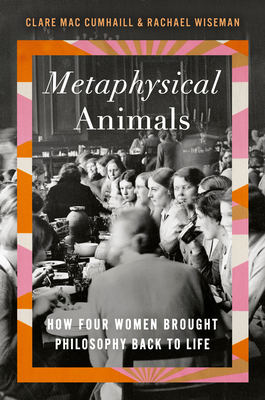How Four Women Brought Philosophy Back to Life
Clare Mac Cumhaill & Rachael Wiseman
Doubleday ($32.50)
by Scott F. Parker
Joining the burgeoning genre of collective philosophical biography, Metaphysical Animals: How Four Women Brought Philosophy Back to Life, by Clare Mac Cumhaill and Rachael Wiseman, puts Elizabeth Anscombe, Philippa Foot, Mary Midgley, and Iris Murdoch at the center of a story of friendship and of analytic philosophy’s renewed interest in metaphysics and morals.
Cumhaill and Wiseman came to their subject thanks to a letter Midgley published “in the Guardian, under the heading ‘The Golden Age of Female Philosophy’” in 2013. Soon after, they visited Midgley to learn the story their book would eventually tell.
Anscombe, Foot, Midgley, and Murdoch converged at Oxford during tumultuous times. Many of the men—professors as well as students—were summoned to World War II; among them was A. J. Ayer, the influential logical positivist and Metaphysical Animals’ bête noire. In his absence, philosophy’s preoccupation with linguistics and its rejection of metaphysics loosened. During the war, the women found themselves at the center of the philosophical scene: “Had it not been for the interruption of war, Mary, Iris, Elizabeth and Philippa may well have joined the men in the effort to usher in the brave new world of a philosophy divested of poetry, mystery, spirit and metaphysics. Or, more likely, they would have finished their degrees and left philosophy behind them, convinced . . . that the subject was not for them.” These were, in other words, bleak philosophical times.
Taking advantage of the opportunity only accidentally available to them, the four were able to pursue philosophy with a more person-centric approach than had been prominent at Oxford. But what the four philosophers had in common beyond their circumstances is where Metaphysical Animals begins to break down. Cumhaill and Wiseman present Anscombe, Foot, Midgley, and Murdoch as members of a movement grounded in gender. Yet, by giving short shrift to the philosophical work in question and opting instead to focus on the day-to-day lives of the philosophers, they fail to draw connections in any but the most general terms—those terms being their opposition to Ayer and logical positivism, which scores of other philosophers shared.
This substantive lightness is only emphasized by the book’s historical frame, which concludes with Anscombe’s opposition to the honorary doctorate Oxford would bestow upon Harry Truman in 1956, thereby relegating all four women’s greatest professional achievements to a brief afterword. This is a missed opportunity to affirm the legacies of four great philosophers, who deserve greater prominence. Consider that the famous Trolley Problem was originated by Philippa Foot. Besides making serious contributions to the philosophy of animals, in her nineties Mary Midgley wrote a defense of philosophy, What Is Philosophy For?, the culmination of a lifetime of thought, that became a surprise mainstream hit. Cumhaill and Wiseman are most thorough in their disquisition of Elizabeth Anscombe, probably the most influential philosopher of the four. They write that “it is thanks to her translation that Wittgenstein’s Philosophical Investigations is recognised as a literary, as well as a philosophical, masterpiece” and call her book Intention “the most important treatment of action since Aristotle.” Murdoch is the best known of the four, though primarily for her novels and for having been portrayed by Kate Winslet and Judi Dench in the film Iris, an impression Metaphysical Animals is unlikely to alter.
Cumhaill and Wiseman say they were “bored of listening to men talk about books by men about men” when they set out on their book. Fair enough. But shoehorning four women who happened to be friends into an ill-defined school only serves to obscure each woman’s unique contributions to philosophy.
Still, though, seeing their early shared lives is not without its pleasures. Metaphysical Animals is a period piece, replete with dress codes, cigarettes, and ubiquitous casual misogyny. It is a portrait of four philosophers as young women. Here they are, for example, sitting down together for conversation: “Philippa explained her idea over the clatter of the busy café, the Nippy serving up a pot of hot tea for Mary and Philippa, black coffee for Iris and Elizabeth.” And so, rather than learning what they thought in their maturity, we will settle for what they drank in their youth.
Click here to purchase this book at your local independent bookstore:
Rain Taxi Online Edition Winter 2022-2023 | © Rain Taxi, Inc. 2023


